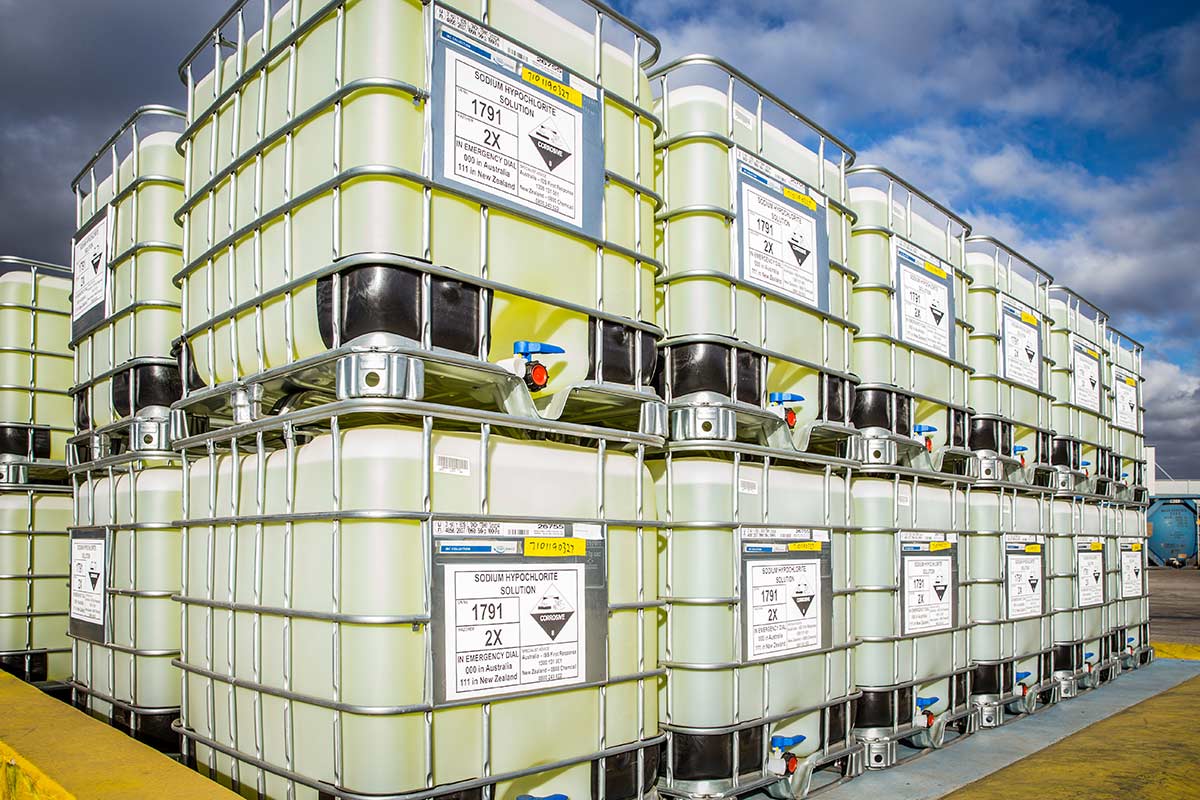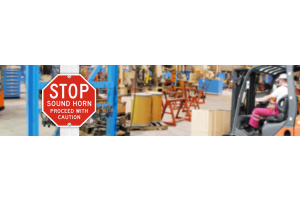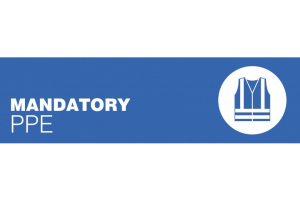
Bulk storage of acids
The storage of acids can create serious risks, not only to people on site, but also to the emergency services, the general public off site, and to the environment. This publication gives guidance on the design, construction, operation and maintenance of installations used for storing hydrochloric acid and nitric acid in fixed tanks. It applies to new installations and to existing installations where reasonably practicable. It is aimed at managers and supervisors, but may also be of interest to designers and installers. Much of this guidance is common to both nitric and hydrochloric acid, but where the advice differs, this is specifically stated. The properties of hydrochloric acid and nitric acid have many similarities but also many differences (see ‘properties of hydrochloric acid’ and ‘properties of nitric acid’ below). Although much of the advice is common to both acids, some is specific to the individual acid. Advice that applies to hydrochloric acid only will be highlighted in green and advice that applies to nitric acid only will be highlighted in orange. Properties of hydrochloric acid chemical formula, HCl, and sometimes known as muriatic acid, widely used as a chemical reagent in the production of many common materials. It is also used for metal pickling and in water treatment processes supplied commercially at concentrations mainly within the range 28% to 36% evolves hydrogen chloride vapour with a sharp irritant odour. The amount of vapour is primarily dependent on the acid concentration, but other factors such as temperature and turbulence can have an effect causes severe injury by inhalation of the vapours or fumes, by splashing on the skin or in the eyes, or if taken internally highly corrosive and attacks most common metals, including iron, steel and lead, producing flammable hydrogen gas reaction with oxidisers such as permanganates, chlorates, chlorites and hypochlorites may produce chlorine gas reactions are accompanied by the generation of toxic and corrosive fumes, the rate of reaction depending largely on the concentration.
Properties of nitric acid chemical formula, HNO3 widely used for the production of fertilisers, polymers and dyestuffs and for metal pickling, cleaning and plating supplied in a range of concentrations. Commercially, the most common concentrations supplied are between 60% and 70%, known as ‘weak’ or ‘aqueous’ nitric acid and above 92% known as ‘concentrated’ nitric acid evolves toxic and corrosive fumes. The amount of vapour is primarily dependent on the acid strength (concentrated nitric acid is described as a fuming liquid) but other factors such as temperature and turbulence can have an effect causes severe injury by inhalation of the vapours or fumes, by splashing on the skin or in the eyes, or if taken internally highly corrosive and attacks most common metals, producing flammable hydrogen gas a strong oxidising agent and a serious fire hazard on contact with combustible substances such as straw, coke, charcoal, paper, sawdust, and sacking reacts with alkalis, metal bases and organic materials to form nitrates or nitro compounds reacts violently with most metal powders, carbides and chlorides reactions are accompanied by the generation of toxic and corrosive fumes, the rate of reaction depending largely on the concentration.
Risk assessment, The storage of acids can create serious risks, not only to people on-site, but also to the emergency services, to the general public off-site and to the environment. The greatest risk of significant harm is a large spill or leak from tanks or pipework or associated plant. The main causes of such incidents include: failure to detect corrosion and replace corroded components; damage caused by the impact of vehicles or other objects; overfilling; mixing with incompatible substances. Even small spills and leaks can produce serious injuries if people come into contact with the liquid or inhale the fumes. Minor incidents can develop into major incidents if prompt emergency action is not taken. Under the Management of Health and Safety at Work Regulations 1992,1 every employer has a duty to carry out an assessment of the risks to the health and safety of employees and of anyone who may be affected by the work activity. This is so that the necessary preventive and protective measures can be identified and implemented. HSE recommends a five step approach to risk assessment:.
- Step 1: Look for the hazards.
- Step 2: Decide who might be harmed, and how seriously.
- Step 3: Evaluate the risks arising from the hazards and decide whether existing precautions are adequate or more should be done.
- Step 4: Record your findings (this is a statutory requirement if you have five or more employees).
- Step 5: Review your assessment from time to time and revise it if necessary.
Your risk assessment should include risks arising from the tank and risks to the tanks from external sources. The aims of the assessment are to: minimise the likelihood of a spillage; reduce the consequences of such an incident, particularly with regard to people and the environment. When assessing a storage installation you should consider these factors: storage capacity; design standards for the installation; location of the tank in relation to site boundaries, roadways, buildings, process areas, drains, waterways; activities on adjacent premises; quantities and locations of other dangerous substances; loading and unloading arrangements; possibility of feeding wrong substances into the tank; training and supervision of site operatives; inspection and maintenance; number of employees and public who might be affected by a leak and their ability to evacuate quickly. You should carry out a risk assessment before installing new facilities, modifying existing facilities or demolishing obsolete facilities. It is a good idea to seek the advice of organisations such as the fire authority, the Environment Agency or Scottish Environment Protection Agency, the Health and Safety Executive and insurance companies. The Control of Substances Hazardous to Health Regulations require employers to assess the risks from exposure to hazardous substances and the precautions needed. Guidance on the risks to health is outside the scope of this book but guidance on the Regulations is available. Siting of the tank When selecting the location of acid storage tanks, consider the distance of the proposed installation from: the site boundary; roadways and site thoroughfares; occupied buildings; storage or processing of other dangerous substances particularly incompatible substances such as strong alkalis and oxidising agents; water courses and boreholes.
The aim is to prevent accidental or deliberate damage by activities on or off site and to protect people and the environment. Acid storage tanks are usually installed at ground level because construction and tank maintenance are less costly, gauging and pumping are easier, and leaks are easier to detect. As corrosion cannot be completely eliminated, good access for inspection and maintenance is essential. Tanks can be horizontal or vertical. Horizontal tanks are generally considered easier to repair and maintain but vertical tanks use less space and the ground support is less expensive. Also, stock taking and level control is more accurate in vertical tanks. The tank foundation (and the supports for horizontal tanks) should normally be of concrete with the required load bearing strength and thickness. The size of the tank needs careful consideration. Keep stock levels as low as reasonably practicable, taking into account process demands and the frequency and size of deliveries. Bunding, the probability of a major leak from a well-designed and maintained storage system is low, particularly if overfill protection has been fitted However, the consequences of an acid spill are potentially very serious and measures to contain spillages or leaks from acid storage tanks should be provided. Bunding is the usual method to contain spills or leaks from vessels. The purpose of the bund is to: prevent the liquid entering drainage or other water systems; prevent the spread of the liquid which could present a hazard to other plant or personnel both on and off site; prevent contamination of land; allow the controlled recovery or treatment of the spilled material. The bund walls and floor should be constructed of materials resistant to the acid being stored. Acid resistant tiles are available and bricks and cement can be faced with acid resistant coatings. Coatings will require maintenance and regular renewal. The choice of materials will depend on the acid itself, its concentration and temperature. If in doubt, contact the supplier. The bund should have sufficient capacity to contain the largest predictable spillage. A bund capacity of 110% of the capacity of the largest storage vessel within the bund will normally be sufficient. Consideration should be given to the provision of individual bunding for each acid tank to prevent damage to other tanks if a leak occurs. Chemicals which react with the acid should not share the same bund. The bund walls should have sufficient strength to contain an acid spill (taking into account the density of the acid stored). For example, a bund wall constructed of 225 mm bricks or blocks with a height in excess of 600 mm is likely to collapse if it has to contain major spillages. If a height greater than 600 mm is required then you may need to use additional strengthening, such as using a greater thickness of brick or block, reinforced concrete or buttresses. A fixed means of access to the bund may be necessary. Rainwater should not be allowed to accumulate in the bund. Methods for the removal of bund contents (eg acid spills or rainwater), such as a sump and a manually controlled sump pump, should be provided. Bund liquids should be analysed as necessary before removal or disposal to prevent contamination of drainage systems. If a drain valve is used it should be kept locked in the closed position and only used by authorised personnel. The drain valve and any associated piping should be made of materials compatible with the acid stored.
Proprietary tanks supplied with an integral covered bund should not normally need additional bunding. However, there should be a way of monitoring the soundness of the tank and bund. This can be done, for example, by monitoring the liquid level, vacuum or pressure in the space between the tank and bund. The monitoring system should provide an alarm if a leak is detected. Equipment such as pumps and tanker hose connections can give rise, in normal operation, to small spillages which can cause damage to concrete and other surfaces over a period of time. Preferably, they should be positioned in a separate (acid resistant) catchment area outside the main bund. This should also ensure easy access to equipment. The tank and the bund wall should be protected from possible mechanical impact from vehicles and mobile equipment. If necessary, crash barrier type protection should be provided.
Materials of construction
Acids are extremely corrosive and so the tank and any equipment that will come into contact with the acid or its fumes should be made of corrosion resistant materials. The construction materials recommended for hydrochloric acid and nitric acid are given below. Factors to take into account when selecting construction materials include: the properties of the acid itself; the acid concentration; the acid density; the presence of impurities; the storage temperature. It is important when ordering equipment to specify the conditions of use. Where external corrosion could be a problem (for example, of carbon steel), tanks and pipework should be protected using a suitable coating. Construction materials recommended for hydrochloric acid Hydrochloric acid attacks most metals (including stainless steels). Therefore, tanks are constructed of plastics, rubbers, glass and ceramic materials or they are lined with such materials. The following materials are commonly used in the construction of hydrochloric acid storage tanks: UPVC reinforced with resin impregnated fibreglass; high density polyethylene; polypropylene reinforced externally with resin impregnated fibreglass; carbon steel lined with a suitable grade of rubber. Although plastics can have excellent chemical resistance, they can have physical limitations. For example, some materials may not stand up to pressure, some are affected by heat, sunlight or cold temperatures, and some are brittle and easily damaged. Glass is also compatible with hydrochloric acid but is generally not used in the construction of bulk tanks. It is commonly used for linings and in the construction of other components
Tank design, Factors to take into account in the tank design include product density, capacity, the materials of construction and delivery method. Delivery method is important as acid may be delivered by one of three techniques: pump discharge, pump discharge with vapour return or compressed air discharge (air padding). If compressed air is used, then the tank should be designed to cope with the pressures generated (normally about 2.1 barg or 30 psig). To ensure mechanical integrity, storage tanks should be designed and constructed in accordance with an appropriate British or European standard or any other national or international standard that provides an equivalent level of safety. Standards for tanks operating at atmospheric pressure include: PrEN 14015-1;7 BS EN 14015:2004;8 BS EN 12285-1:2003, BS EN 12285-2:2005;9 BS 4994:1987.10 The standard for tanks operating above atmospheric pressure is: PD 5500:2000.6 Vents and overflows. Vents should be sized to prevent overpressurisation of the tank during product delivery, and partial vacuum when product is being removed from the tank. The size and design of the vent will depend upon the type of tank, its material of construction, and whether tanker delivery is made using pump discharge or compressed air. Normally, the vent is at least 150 mm (6 inches) in diameter, fitted on top of the tank and venting to a safe location. Bulk storage of acids.
Atmospheric tanks should have separate vent and overflow lines. The overflow should be sized to prevent any pressure build up within the tank in the event of an overfill. The overflow diameter should be equal to or greater than the inlet diameter. Normally, the overflow is at least 100 mm (4 inches) in diameter and at least 350mm below the vent base. It should terminate as close to the ground as possible within the bund or other contained area. To prevent fuming, a dip leg and small water lute can be used. Tanks, which are pressure vessels, complying with PD 55006 can have combined vent/overflow systems. Fume scrubbers, To prevent release of fumes into the atmosphere, vent lines of bulk acid tanks should feed into a scrubber unit. (If necessary, seek advice about discharge limits from the Environment Agencies, see paragraph 9.) The scrubber should be designed to cope with the fumes given off and the pressures generated during the filling of the tank. Water, sodium hydroxide solution or dilute acid solution can be used as the scrubbing medium. Provision should be made to monitor the pH of the scrubbing solutions and to protect against freezing in the winter months. Pipework, Acid transfer lines should be constructed from compatible materials as described in the sections on construction materials for hydrochloric acid and nitric acid. Consideration should also be given to the design and construction of pipe clamps and support structures where they are likely to be exposed to a corrosive environment. Pipelines can be continuously welded or flanged joints can be used. If flanges are used, they should be kept to a minimum and located where they cannot drip on equipment, roadways or walkways or where there are people. Care should be taken to ensure that compatible materials are used for flange bolts, gaskets and packing materials. Butyl rubber gaskets can be used for hydrochloric acid. PTFE based materials are suitable for nitric acid. Pipelines should be securely clamped and sloped for complete drainage. Sharp bends and elbows and other points where acid can accumulate should be avoided. When discharge is by compressed air, there are potential problems associated with vibration, material fatigue and overpressures caused by leaving valves shut. All these points should be taken into account in the pipework design and the choice of materials. All pipework should be protected against foreseeable impact from vehicles or mobile plant.
Valves, All valves should be made of acid resistant materials and should be suitable for the purpose. If necessary, seek advice from the supplier. Every bottom outlet and drain connection on the tank should be provided with a shut-off valve located as close to the tank as possible to reduce the risk of leakage. In some circumstances, such as where the tank is particularly large, additional protection may be required. In these cases, it may be advisable to use two isolation valves in series. The fundamental requirement of isolation valves is that they can achieve and maintain tight shut-off. Plug valves are extensively used for this purpose and are considered to be the most reliable, particularly for concentrated acids. Other types of valve, such as butterfly valves, globe (ball) valves and gate valves can be used but they may not achieve the tight shut-off and reliability necessary for isolation valves. Diaphragm valves should not be used as primary outlet or drain valves because of the possibility of a large spillage if the diaphragm fails. It is essential that isolating valves can be closed quickly and safely in an emergency. Remotely operated shut off valves may be necessary (see Emergency isolation of process plant in the chemical industry. If a slam shut valve is fitted, the closing time should be designed to prevent pressure surges which could cause flanges or pump seals to leak. Valves should be located where they are easily accessible with plenty of working room around them. Use labelling to identify the valve and the valve position (ie open or closed). Drain valves should be securely blanked off when not in use. Pumps, Leakage from pumps can create serious environmental and safety issues and is a particular problem for corrosive liquids. It is essential that the pump is constructed of materials compatible with the acid. Centrifugal pumps of PTFE- lined cast iron or plastic or magnetic driven sealless pumps are commonly used. Where sealed pumps are used they should be fitted with a mechanical seal or fluorocarbon packing since most other forms of gland packing are readily attacked by acid. All pumps should be visually examined for leaks on a daily basis and inspected more thoroughly on a routine maintenance basis. Contents measurement, A reliable contents gauge should be fitted to the storage vessel. Pneumacators, magnetically coupled float gauges or ultrasonic reflection transmitters are the most satisfactory methods of measurement for acid tanks. Diaphragm gauges can also be suitable for installations designed to operate at atmospheric pressure. For installations designed to operate above atmospheric pressure, a differential pressure transmitter should be used. Dipping of acid tanks is generally considered an unsafe practice, and sight glasses should be avoided.
The use of a high-level alarm, with an audible output at the tanker unloading point to alert the driver, is recommended. The alarm may also be arranged to stop the filling pump or close the intake valve. A second high-level trip can also be fitted, which will trigger shutdown of the pump or divert the flow, if no action has been taken following the first high-level alarm. This second high-level trip should be independent of the gauging system to provide overfill protection if the gauging system fails. As noted previously, the closing time of the shutdown valve should be designed to prevent pressure surges, which could cause flanges or pump seals to leak. Signs and labelling, The Health and Safety (Safety Signs and Signals) Regulations 199612 require safety signs to be provided where the risks to employees cannot be avoided or adequately reduced by other means. You may need to provide signs or labels for tanks, pipes, sampling points, joints, valves etc. Examples where signs or labels should be provided include: locations where there are numerous pipes, in close proximity, conveying different dangerous substances, particularly if they have different hazardous properties; offloading points to prevent offloading into the wrong tank; sampling points and drain valves;where there have been significant alterations or additions to fittings and pipe runs. Tanker offloading, Locate the offloading bay in a safe, well-ventilated position. There should be easy access and exit for tankers, preferably without reversing. The offloading area and access road should preferably be dedicated to tanker use only. If this is not practicable, use barriers to control access by other vehicles and personnel during transfer operations. A separate parking bay for road tankers waiting to unload is advisable so that vehicles and documents can be checked with minimum interference to traffic flow. Tankers should not wait on public roads or busy internal roads. The offloading point should be clearly labelled with the product to be handled. It should be locked closed to prevent unauthorised operation. Additional precautions, such as the use of different fittings, may be required if there is a possibility of mixing incompatible liquids. Filling lines and air lines should be fitted with a suitable flange or coupling to connect with the hoses of the delivery vehicle. Dry break couplings or flanged couplings can be used. Take precautions against spillage due to vehicles being moved with the hoses still connected. These include providing barriers across the tanker stand, brake interlocks on the vehicle, clamping or breakaway couplings on the hose connections.
Climbing on top of tankers should be avoided as far as possible. Where access above ground level is necessary, for offloading purposes, provide effective measures to prevent falls, such as access gantries with stairs or ladders, and protective handrails on the tanker top. Acid can be delivered by one of three techniques: pump discharge, pump discharge with vapour return or compressed air discharge (air padding). For pump discharge, the pump may be installed on the site or on the vehicle. As the acid is pumped out, air is drawn into the tanker through the tanker vent valve. The incoming acid displaces air in the storage tank (through a fume scrubber) to atmosphere. If a closed loop vapour return system is used, a connection is made between the headspace in the storage tank and the vehicle so that as liquid is transferred from vehicle to tank, an equivalent volume of air is transferred from tank to vehicle. This greatly reduces acid mist discharges from the tank vent during offloading. For compressed air discharge, an air compressor on the vehicle is used. This builds a head pressure within the tanker, displacing the acid which flows into the storage tank. Check that the tank is designed to cope with the pressures generated (normally about 2.1 barg or 30 psig). This is particularly important for tanks designed for atmospheric pressure. The maximum safe working pressure should be agreed between the site operator and the supplier. At the end of the delivery, the compressed air left in the tanker purges to atmosphere through the delivery pipework and storage tank, clearing the intake lines of acid. The vent scrubber should be designed to cope with this surge of fume. Before unloading the tanker, check placards and the accompanying delivery notes to ensure, so far as is reasonably practicable, that the material being delivered is what it is supposed to be. This is particularly important if incompatible materials are stored on site. Before acid is unloaded from a tanker into a storage tank the site operator should ensure there is enough ullage space in the tank to take the load. Provide written procedures covering all aspects of the operation. They should be reviewed and agreed with the supplier before any delivery commences. They should include: careful checking of the load details and the tank ullages; inspection of hoses and other items of equipment; measures to prevent the vehicle moving while hoses are connected; the transfer procedure; emergency procedures.
All operations should be under the control of a designated person, who should be present at all times during the transfer and ensure that the procedures are followed. The designated person should have the necessary training and experience for the task. Deliveries into metal pickling baths, The recommended mode of delivery is into a separate storage tank but, in the metal pickling and galvanising industries, deliveries are often made into the pickling baths themselves. Precautions are necessary to prevent splashing and fuming. The site operator should provide a fixed point of connection for the tanker discharge hose and the lowest acid concentration sufficient for the process should be used. As with deliveries into conventional bulk storage tanks, there should be written procedures for the offloading process. These procedures should be reviewed and agreed with the supplier before any delivery commences. All operations should be under the control of a designated person, who should be present at all times during the transfer and ensure that the procedures are followed. The designated person should have the necessary training and experience for the task.
Inspection and maintenance, Health and safety law14,15 requires that plant and equipment be maintained in a safe condition. In addition, there are specific legal requirements for pressure systems.16,17 Many of these requirements are good practice for non-pressure vessels. The type and frequency of inspection and maintenance should be determined using a risk assessment approach based on tank service, maintenance history and known corrosion rates. Only personnel who are suitably qualified and authorised, and who fully understand the hazards, should carry out this exercise. It is good practice to list the component parts of the installation on a preventive maintenance schedule, containing details of the scope and frequency of the planned inspection and maintenance work. Under the pressure systems legislation, the examination of tanks, pipework and fittings must be carried out by a competent person. This could be a specialist inspection engineer employed by an insurance company or an employee with the appropriate qualifications and experience.
The operator and the competent person should agree a written scheme of examination, to include the scope and frequency of thorough examination. Keep records of all examinations, tests, modifications and major maintenance. Schemes of examination should be in writing and should be reviewed regularly. For new installations, the manufacturer of the tank will normally pressure test it, in accordance with the design code used, before supply. Before filling with acid, the installed tanks and pipework should be cleaned, leak tested, drained and dried. Hydraulic testing is preferred to pneumatic testing for safety reasons, although air may be used as a means of applying pressure to water filled tanks and piping. All leaks or other faults should be corrected before the tank is first used. Note that acid is more dense than water. The pressure test should simulate the density of the material to be stored in the tank eg by using brine solutions to increase the density. If this is not done, leaks may be found during initial filling of the tank.
Hydrochloric acid, Take particular care to avoid damage to the lining of rubber-lined tanks (hydrochloric acid only). Liner failure will be evident via a colour change in the acid as iron from the tank’s steel is exposed and converted to a soluble salt. The following procedures will help to increase the life of a rubber-lined tank: wash the tank only when necessary; guard against cuts of any sort; do not alternate from one service to another; guard against harmful agents such as oil, grease or solvents; do not weld or burn on or near the tank (heat may affect the lining). Inspection and maintenance of acid tanks is a hazardous task. Tanks, pumps, pipelines etc should be drained and flushed with water before being repaired.
All personnel involved in the maintenance activity should wear appropriate personal protective equipment such as clothing which is chemical resistant. Care should be taken to avoid contact with any washings. This can be a particular problem with nitric acid which does not mix easily with water because of the different viscosities. Although neither hydrochloric acid nor nitric acid is flammable, they will attack most metals, producing hydrogen gas. For example, if the lining of a hydrochloric acid tank is damaged, then the acid will attack the exposed metal.
The hydrogen produced could accumulate within the tank and form an explosive mixture with air. Consider this possibility before any maintenance work is undertaken. Do not allow any ignition sources in the vicinity of the tank until any possible gas accumulation has been dispersed by ventilating. The tank should be earthed to prevent static build-up and this should also be checked regularly. Consider, also, whether to carry out earthing and continuity testing of the road tanker. Working areas associated with storage tanks, including loading and unloading points, should be adequately lit when in use. An average illuminance of at least 50 lux is recommended at ground level and on stairs, access platforms etc.
It may be necessary to increase this to 100 lux where reading or detailed work is required.
You should carry out a risk assessment to determine the need for personal protective equipment (PPE) including respiratory protective equipment (RPE).19,20,21 For example, when handling hydrochloric or nitric acid, acid resistant clothing, goggles or full face shield, PVC gauntlets and rubber boots should be worn. Maintained and fully charged self-contained breathing equipment and full protective clothing should be kept to hand, to deal with any major spill. Anyone who needs to use PPE and RPE must be properly trained in its use and its limitations. The equipment must be maintained, kept clean and examined at periodic intervals. Eye wash bottles and cold water showers fitted with an eye irrigation facility should be available and clearly visible in all locations where the acid is handled. Such facilities should be regularly inspected and eye wash solutions changed.
Emergency procedures, draw up an emergency procedure to deal with acid leaks and spills. It should include the duties of all staff and the arrangements for: raising the alarm; evacuation; calling the emergency services; first aid; plant isolation. The manner in which a spill is handled will depend upon the amount of acid involved, its concentration and where the spill occurs. All responding personnel should be equipped with self-contained breathing apparatus and full protective clothing. Other people should evacuate to a safe place upwind of the spill area. Minimise spills by closing valves and stopping transfers, if it is safe to do so. The emergency procedures should include drawings identifying the location of key valves and how to operate them. Where there is the possibility of large spillages outside bunded areas, ensure you have a way to prevent them spreading or escaping into water courses. Sandbag bunds are the most effective method of containment in such cases. Where possible, the spilled acid should be pumped into marked containers for future reclamation or disposal. A water spray or fog may be used to control vapours.
It is essential that any equipment used (such as the pump and containers mentioned above) is suitable for use with hydrochloric acid or nitric acid, as appropriate. Absorb small spills or the residues from large spills with sand or earth or other compatible absorbent materials. The materials can then be swept up and the sweepings placed in suitable, marked containers for disposal. The affected area should then be washed thoroughly with water. You can also treat small spills by careful dilution with water and neutralisation with sodium carbonate (soda ash) or hydrated lime before applying the solid absorbent. When carbonate or bicarbonate is used, ample ventilation should be provided because carbon dioxide saturated with acid fume will be evolved. Do not use caustic soda (sodium hydroxide) to neutralise a spillage as the reaction with acids is very vigorous producing copious toxic fumes.
Nitric acid, Concentrated nitric acid is a strong oxidising agent and can cause a fire risk if it comes into contact with readily combustible materials. Prevent the spill from coming into contact with such materials. Wood, fabric rags etc should not be used for the clean up exercise. Any contaminated combustible material must be disposed of carefully to minimise the risk of fire. Hydrochloric acid Take care to prevent hydrochloric acid mixing with oxidising agents as toxic chlorine gas may be generated. Care should also be exercised if water is used to dilute concentrated acid as part of the clean up process. As described earlier, water and concentrated acid have very different viscosities and can be difficult to mix. The acid concentration of washings can vary considerably. Take protective measures to avoid contact with all acid washings. Training, The provision of adequate information and training is a requirement of several pieces of legislation.1,14,15 Everyone on site should be informed of the hazards from acids. Those handling acids should also receive specific training in both normal operating procedures and emergency procedures. Periodic retraining will usually be necessary. A typical training schedule will include the following: hazards and properties of the liquids stored; safe operating procedures for the installation and its associated equipment; the use of personal protective equipment; the action to be taken if a fault or corrosion is detected; dealing with minor leaks and spills; he importance of preventive maintenance; emergency procedures.




